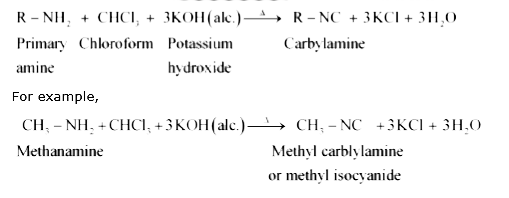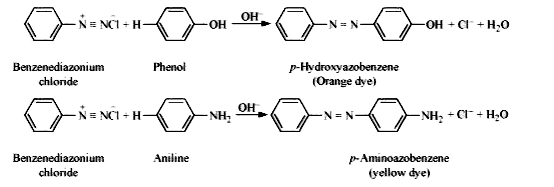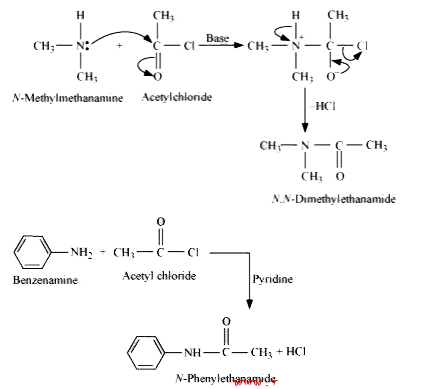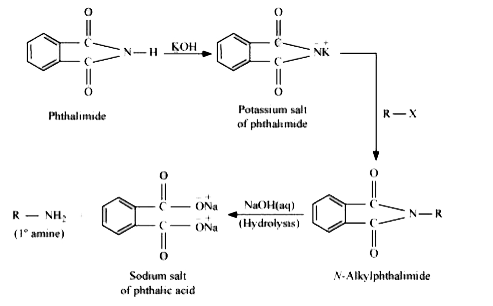Write short notes on the following :
i. Carbylamine reaction
ii. Diazotisation
iii . Hofmann bromamide reaction
iv.Coupling reaction
v. Ammonolysis
iv. Acetylation
vii. gabriel phthalimide synthesis
(i) Carbylamine reaction
Carbylamine reaction is used as a test for the identification of primary amines. When aliphatic and aromatic primary amines are heated with chloroform and ethanoic potassium hydroxide, carbylamines (or isocyanides) are formed. These carbylamines have very unpleasant odours. Secondary and tertiary amines do not respond to this test.

For example,
(ii) Diazotisation
Aromatic primary amines react with nitrous acid (prepared in situ from NaNO2 and a mineral acid such as HCl) at low temperature (273-278K) to form diazonium salts. This conversion of aromatic primary amines into diazonium salt is known as diazotization.
For example, on treatment with NaNO2 and HCl at 273+278 K, aniline produces benzenediazonium chloride, with NaCl and H2O as by products.

(iii) Hoffmann bromamide reaction
When an amide is treated with bromine in an aqueous or ethanolic solution of sodium hydroxide, a primary amine with one carbon atom less than the original amide is produced. This degradation reaction is known as Hoff man bromamide reaction. This reaction involves the migration of an alkyl or aryl group from the carbonyl carbon atom of the amide to the nitrogen atom.

For example,

(iv) Coupling reaction
Coupling reaction
The reaction of joining two aromatic rings through the −N=N− bond is known as coupling reaction. Arenediazonium salts such as benzene,diazonium slats react with phenol or aromatic amine to form coloured azo compounds.

It can be observed that, the para-position of phenol aniline are coupled with the diazonium salt. This reaction proceeds through electrophilic substitution.
(v) Ammonolysis
When an alkyl or benzyl halide is allowd to react with an ethanolic solution of ammonia it undergoes nucleophilic substitution reaction in which the halogen atom is replaced by an amino (−NH2) group. This process of cleavage of the carbon-halogen bond is known as ammonolysis.

When this substituted ammonium salt is trated with a strong base such as sodium hydroxide, amine is obtained.
R−+NH3−XNaOH→R−NH2Amine+H2O+NaX
Though primary amine is produced as the major product, this process produces a mixture of primary, secondary and tertiary amines, and also a quaternary ammonium salt as shown

(vi) Acetylation
Acetylation ( or ethanoylation ) is the process of introducing an acetyl group into a molecule .

Aliphatic and aromatic primary and secondary amines undergo acetylation reaction by nucleophilic substitution when treated with acid chlorides, anhydrides or esters. This reaction involves the replacement of the hydrogen atom of −NH2 or >NH group by the acetyl group, which in turn leads to production of amides. To shift the equilibrium to the right hand side, the HCl formed during the reaction is removed as soon as it is formed . This reaction is carried out in the presence of a base ( such as pyridine ) which is stronger than the amines.

When amines react with benzoyl chloride, the reaction is also known as benzoylation For example,

(vii) Gabriel phthalimide synthesis
Gabriel phthalimede synthesis is a very useful method for the preparation of aliphatic primary amines. It involves the treatment of phtalimide with ethanolic potassium hydroxide to form potassium salt of phtalimide. This salt is further heated with alkyl halide, followed by alkaline hydrolysis to yield the corresponding primary amine.

Related Playlists
Similar Questions
Write short notes on the following :
i. Carbylamine reaction
ii. Diazotisation
iii . Hofmann bromamide reaction
iv.Coupling reaction
v. Ammonolusis
iv. Acetylation
vii. gabriel phthalimide synthesisView SolutionWrite short notes on the following:
Carbylamine reactionView SolutionWrite short note on the following :
(i) Carbylamine reaction
(ii) Diazotization
(iii) Hoffmann's bromide reaction
(iv) Coupling reaction
(v) AmmonolysisView SolutionWrite short notes on the following:
Hofmann-broamide reactionView SolutionWrite short notes on the following:
Coupling reactionView SolutionWrite short notes on the following :
(i) Carbylamine reaction(ii) Diazotisaton(iii) Hoffmann's bromamide reaction(iv) Coupling reaction(v) Ammonolysis(vi) Acetylation(vii) Gabriel phthalimide synthesisView SolutionWrite short notes on the following :
(i) Carbylamine reactions .
(ii) Gabriel-Phthalimide synthesisView SolutionWrite short on the following :
(i) Carbylamine reaction
(ii) Hofmann's bromamide reaction
(iii) Gabriel phthalimide synthesis.View SolutionWrite short notes on the following:
Gabriel phthalimide synthesis.View SolutionWrite a short note on coupling reaction.
View Solution

